In the last newsletter I wrote that prospects for February grayling fishing were entirely dependent on the rain stopping. Well, as we all know by now, the rain did not stop. I fished a local lake for some rainbows this morning, using Black Lures fished slowly on an intermediate line in the rain…and the rain is pouring down the office windows now as I type. This one is Storm Jorge and prospects are not very good. The westerly winds bringing low pressure systems and rain in from the Atlantic, the same weather which has dogged us all winter, seem set to continue. There was a brief respite in early February which did allow some fishing (mostly trotting) on the upper river and tributaries for several days.
Thus I have only a handful of grayling to report this time. On 1st February SW and NJ from Hereford fished the top of the Irfon at Cildu and reported 8 fish on heavy nymphs. JA from Leominster enjoyed himself on the 6th taking two grayling with a single nymph at Abbeydore, but he was adamant that this beat is badly overgrown and in need of maintenance. (This really should not be the case as Abbeydore and indeed all the Monnow beats have been adopted for maintenance over several years now). GP from Chatham with a friend had 4 grayling trotting at Cefnllysgwynne. The following day MF from Redditch used the same method to take 5 grayling from Court of Noke on the Arrow. NH of Bristol had 5 grayling on nymphs from the main river at Ty Newydd. CP of Swansea was another who tried Abbeydore on the 8th, the first time in 5 years apparently. He had just one grayling to report apart from the out of season trout, but he appreciated a rare few hours of sunshine in the most beautiful part of the Golden Valley.
Already the first gusts of Storm Ciara were apparent. During the night it arrived in full strength, and by dawn the wind was so strong that rain was flying horizontally across the landscape. Out of doors it was like being sprayed with a fire hose. As far as I know, nobody went fishing. Due to prior arrangements made, I went shooting along with a few other idiots, but cartridge pockets were filling up with water and the clays were wobbling around the sky like passenger jets desperate to land. I certainly didn’t hit many. By the end of the day the rivers were once more in high flood and within 24 hours the Wye had burst its banks around Ross. A week of lesser showers followed, offering some hope that the rivers would return to fishable levels. However, before this could happen Storm Dennis arrived with a huge and extended precipitation onto saturated ground. This time the Usk burst its banks first and began to wander over the fields around Abergavenny and Crickhowell. The Wye was soon to follow.
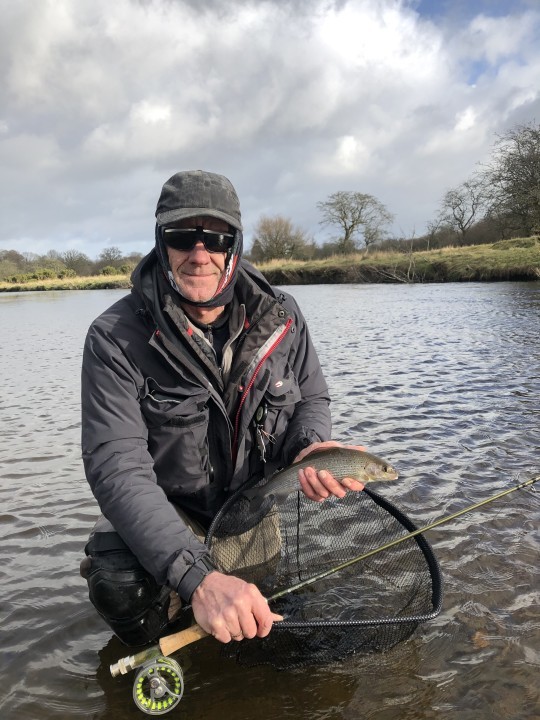 Cildu grayling - SW and NJ from Hereford
Cildu grayling - SW and NJ from Hereford 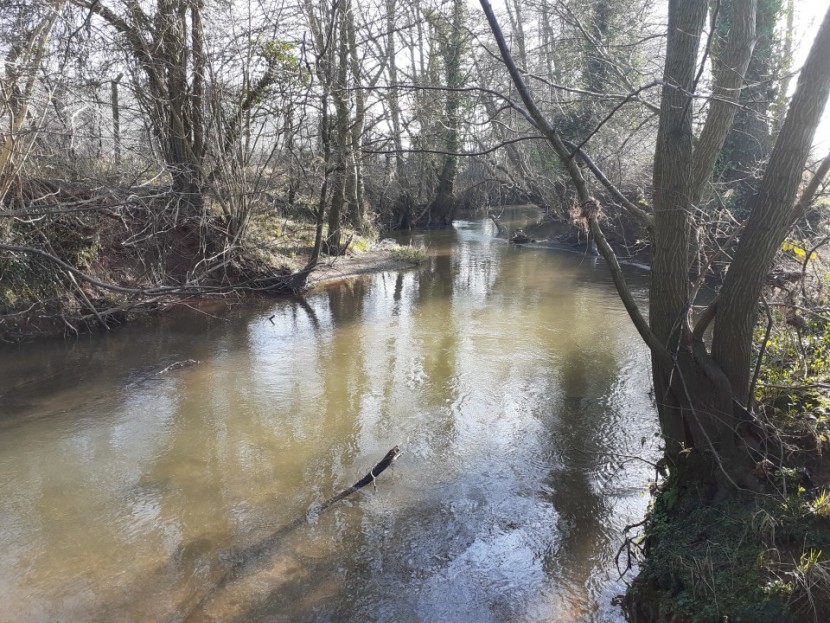 Abbeydore - JA from Leominster
Abbeydore - JA from Leominster 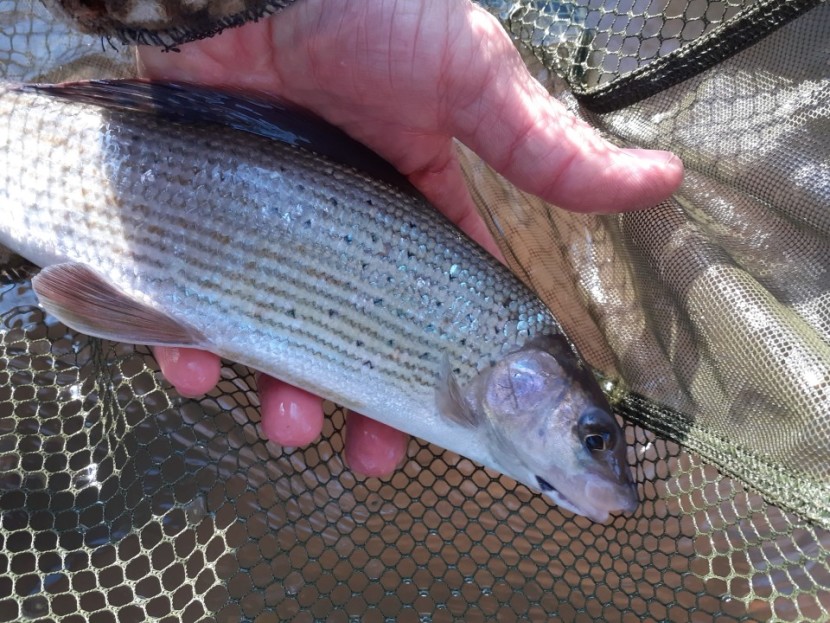 Dore grayling - JA from Leominster
Dore grayling - JA from Leominster Rather than stay indoors I greeted Storm Dennis, not with shooting this time, but a trip to the Big Wells Fishery at Redbrook where one spring-fed pool always remains clear, even while every other piece of moving and still water in the district is thick with red silt. What is more, this clear pool always fishes well when a wind ruffles the surface. It was surely ruffled on this day. I fished a little Hare’s Ear dry fly with a 9 foot 5 weight rod and caught seven rainbows during the morning, by which time I was thoroughly soaked and glad to head home.
Meanwhile, PB from Leicester with a friend arrived at 7.30 on the Irfon at Cefnllysgwynne to find a river already high but now rising – usually the worst of conditions to be faced with. However, by fishing against the clock with trotting rods they managed 4 grayling, including a good one. It was all over in a couple of hours, but well done!
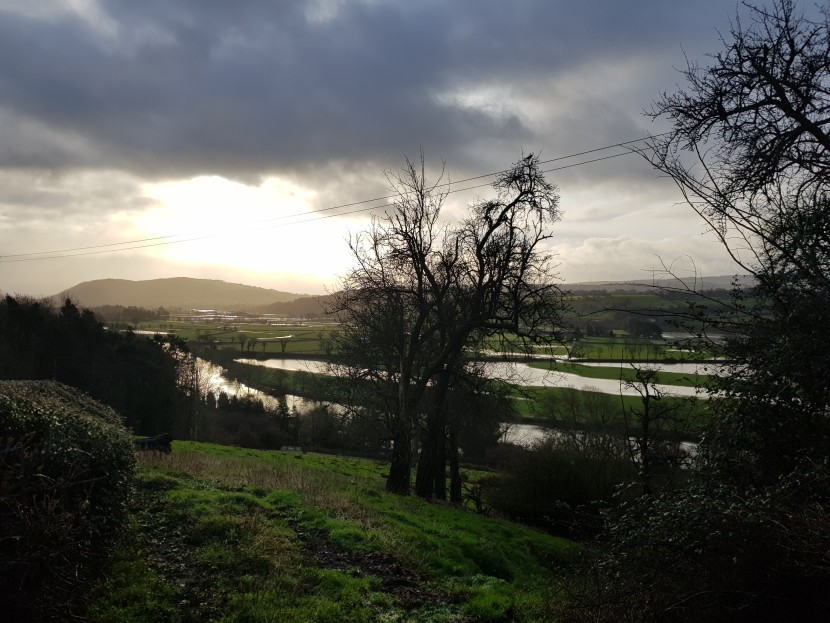 The Wye at Whitney after Storm Dennis
The Wye at Whitney after Storm Dennis 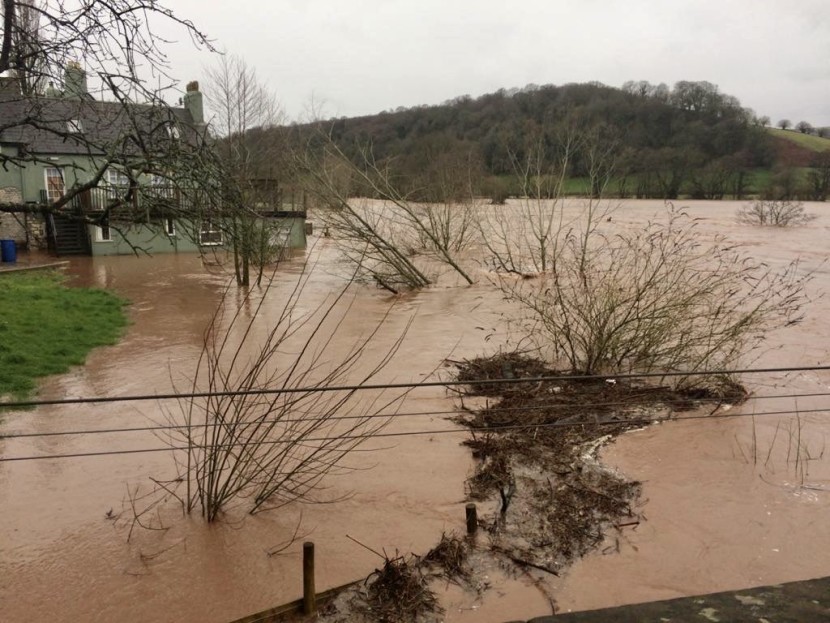 Flooded Usk and the Chainbridge pub
Flooded Usk and the Chainbridge pub On the second day of Storm Dennis, I did shoot at Devauden where you have the luxury of firing into the gale from open-sided sheds. However, by that second day we were starting to realise that the weather had become more than just interesting, no longer something to smile ruefully about, and that it might even be life-threatening. The problem was that the rain just did not stop. This time our border region seemed to have been hit worse than any other and major incidents were declared in Worcestershire, Herefordshire and South Wales.
You will have seen the pictures: our familiar riverside towns were now on national news broadcasts showing flooded homes and cars, while emergency services carried out evacuations by inflatable and even helicopter. Main roads and railway lines were blocked, hundreds of properties were inundated and the damage stretched from Tenbury Wells on the River Teme down to the valley of the Neath in South Wales. Cars were swept away in Hay on Wye while record levels were experienced at Hereford. As the river surges moved downstream, concern switched to Usk town and the Gwent flats, and to the larger populations living on the middle and lower Severn. Below my own town, the flatlands along the Severn estuary known as the Tack flooded behind the sea wall. It was very interesting to look down on this watery scene as certain ancient wooded coverts turned out to be natural islands. Back in town at the bottom of the hill the Rugby ground and tennis club went under the waters and Lakeside Drive, always something of a dubiously named black spot, seemed to have become fully incorporated into the fishing and boating lake. At times like these, I feel grateful that we have kept a Landrover in the family all these years.
Even the smaller streams caused chaos around the Forest of Dean and in Monmouthshire – all it takes is a dip in the road and a blocked drain for a lake to form; the traffic is stopped and somebody’s house is flooded. Not for the first time we had concerns about the capacity of the outfall grid of our Forest pool to deal with the flow and the risk of overtopping damage to the dam which carries a main road and services. One of our sons, living near Ross on Wye, is a linesman for the power company and he was working overtime day and night dealing with outages as the wind and rain continued. The first part of February had been merely problematic for sportsmen and farmers; the rest of the month turned into a disaster for everybody and several lives were in fact lost.
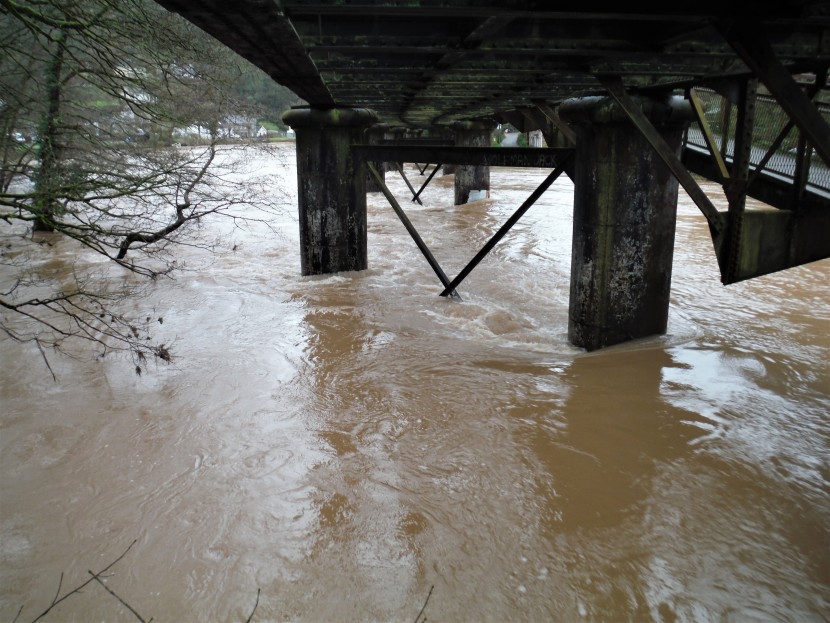 Redbrook railway bridge
Redbrook railway bridge 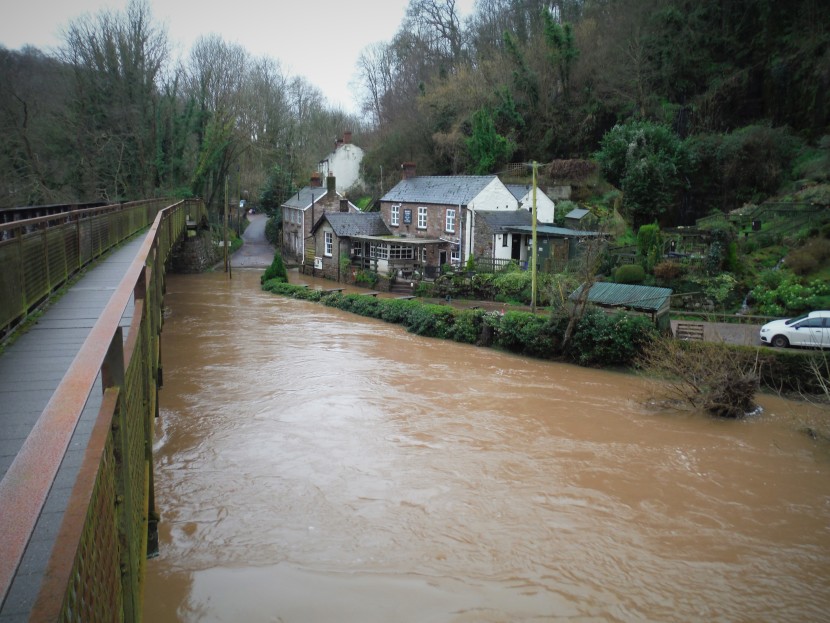 The Boat Inn Redbrook with its feet in the water
The Boat Inn Redbrook with its feet in the water So we come to the end of the 2019-20 grayling season and this time it was truly one to forget. I cannot recall being kept from the river by floods for so many weeks or even months at a time. High water began in September and continued throughout the winter. A few grayling were finessed out here and there, and well done to those who managed it and even more so to those who tried. Predictably in the spate conditions, the trotting method had a definite edge over the fly rod and nymphs. However, for much of the winter any serious fishing was close to impossible.
Here’s a bit of fun to cheer us up, as suggested in the March edition of Trout and Salmon. The magazine (which incidentally is about to merge with Trout Fisherman after many years of separate publishing under the same owner) has printed a list of famous people, historical and living, who also by the way, happen or happened to be game anglers. It is a matter of continual delight to me the way angling as a past-time – even as an obsession – seems to interest interesting people. Most names on the Trout and Salmon list are familiar as anglers, from Sir Humphrey Davy to Neil Armstrong, but I didn’t know President Eisenhower fished and for that matter I didn’t know that the actor Liam Neeson fishes. Virginia Woolf was a slightly surprising name to find on the list. Trout and Salmon notes that while politics and the arts are well represented there is a slightly surprising shortage of fishing people from business, the military and science on the list…although who was Sir Humphrey Davy if not a man of science and who was President Eisenhower for most of his life if not a soldier? (Incidentally I did some research on Eisenhower and struck gold at once with the writing of Mick Lunn, third generation of Lunns to be head keeper for the Houghton club on the Test. Of course Southwick House, which was the advanced headquarters of the Allied Supreme Commander from 1943 on, is not too far away from Stockbridge. Bedell Smith, Eisenhower’s brilliant Chief of Staff, took up the invitation to fish on no less than four occasions, before bringing Ike along to fish also. Mick was a teenager then, but he and his father went out with the two generals on the river for the day. There was fishing and quiet talking. I don’t doubt that “Beetle” Smith was concerned to lift the stress from the shoulders of his boss, the man virtually responsible for the future of the western world, for a few hours at least).
Anyway, Trout and Salmon are asking for some more nominations in the missing categories. Whom would you suggest? For fly fishing tendencies in the military field, quite apart from the obvious Admiral Nelson, I would like to nominate Field Marshall Allenby, the British commander who in the First World War pushed the Turks out of Jerusalem and Damascus with some help from an army of Arab irregulars led by TE Lawrence. Lord Allenby has one large memorial of course. Today, when you leave the Israeli-occupied West Bank for the modern Kingdom of Jordan, Trans-Jordan as it was once known, you cross the river by the famous Allenby Bridge. That has been destroyed in several wars since it was originally built in 1918, but always reconstructed. By all accounts the fishing connection turned out to be a strong one. Lord Allenby spent most of his post-war retirement enthusiastically fishing the chalk streams of Hampshire and Wiltshire. A young keeper at the Officers’ Fly Fishing water named Frank Sawyer used to take him out on the Avon.
Now I’m going to suggest another bit of fun for anybody who likes a quiz…or the movies for that matter. Keeping Allenby in mind, the challenge is to tell us all the three fishing references which come up in David Lean’s famous film Lawrence of Arabia. This may seem a bit of frivolous nonsense given the relatively serious subject matter of the film, but, if it amuses you, just tell me the scene, the background and any relevant lines. Dig out the old DVD and have a look. I should warn you that the first fishy reference is not quite as obvious as the following two. However, I’m sure any angler will notice it. I will report the results in the next letter.
A new season is coming; how do you plan to fish it? Now we all have them, don’t we? I’m referring to the so-called “comfort zones,” those favourite angling methods which enable us to fish with confidence from the very first cast. This confidence, inspired by familiarity and past success, will last us for quite a few casts until yet another success reinforces that long-held belief in the method, in which case we go on with it. Alternatively perhaps, a sinking feeling produced by a lack of result as the day goes on will eventually inspire the beginning of a scramble through all the fishing methods we have ever heard described. You might call this kind of fishing an example of intelligent experiment; on the other hand you might call it near-desperation and desperation rarely results in success in any activity. I have often thought that you might guess an angler’s particular comfort zone merely by knowing his age. Fashions come and go in fly fishing and we have all been affected by them at some time or another in our fishing lives. Consider these fly-fishing types, all of whom I have met at one time or another by rivers and lakes. I am sure you will recognise at least some of them yourself, even if you don’t exactly fit into any of the categories personally.
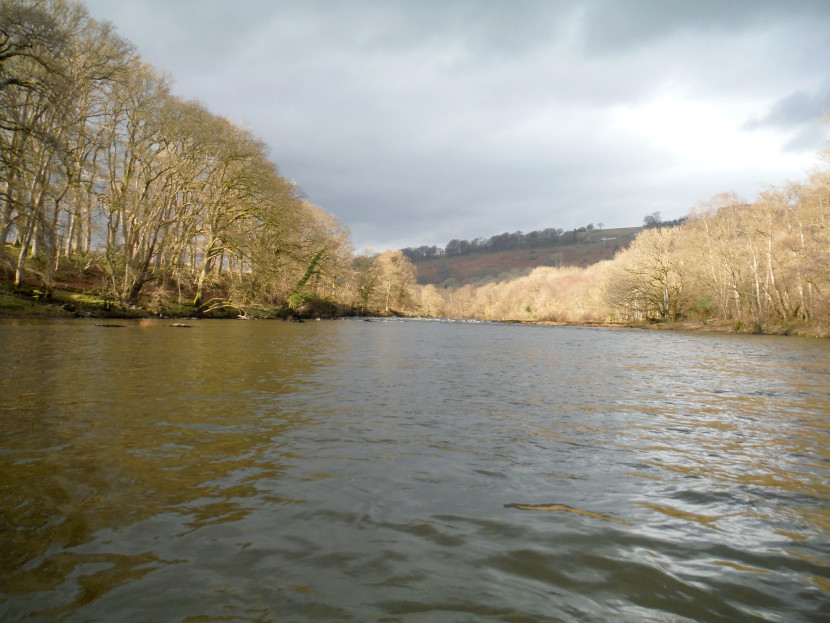 Rare sunshine at Ty Newydd
Rare sunshine at Ty Newydd 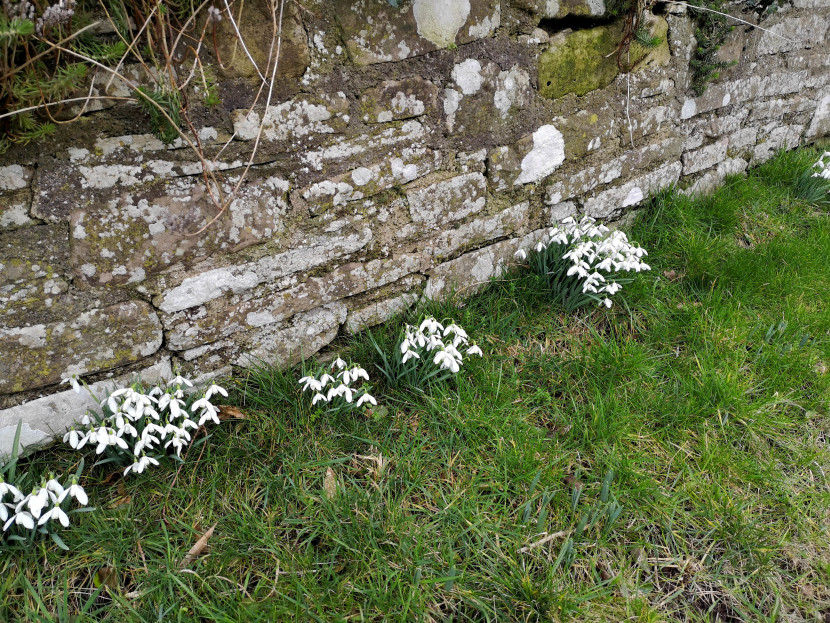 Snow drops at Craswall, the valley of the Upper Monnow
Snow drops at Craswall, the valley of the Upper Monnow The Southern Dry Fly man. I am very fond of this one. He is likely to be quite elderly, maybe in his seventies now. Having come from what we used to call a privileged background, he has been able in the past to afford a certain amount of chalk stream experience. Very likely he has childhood memories of family salmon fishing trips to Scotland also. The long-established dry fly man no longer cares so very much about what he catches – he has long passed the stage of needing to demonstrate his fishing skills to himself or others - but he cares very much about how he catches fish. He just loves the sight of a dry fly floating down the river and being sucked under by a trout. To be honest, he isn’t that interested in any other method although he has experimented with a single upstream nymph sometimes in the past. He couldn’t quite be described as a strict Halfordian, because even in his time Halford’s more rigid ideas had been debunked.
However, you can put our friend down as something of an angling intellectual, a reading kind of angler with well-stocked book shelves. For example his experiments with nymphs were provoked by reading the works of Skues, Oliver Kite and perhaps Frank Sawyer, figures from the intermediate past for whom he accords a due respect. More recently he has read Brian Clarke and Conrad Voss Bark. He feels an affinity to some extent with Laurence Catlow’s writing, although he himself is not one to rage against the modern world. Somehow he cares more about trout than about grayling, because he recalls a time in his fishing when grayling were regarded as a lesser species which, when caught, were supposed to be destroyed for the good of the trout population. For this reason perhaps he is a summer visitor to the river, not being seen often on the bank during the winter months. His tackle is old but good, he takes his time about his fishing – he may even smoke a pipe occasionally - and he beams at everyone he meets. He is fond of small children and dogs. Younger members of his syndicate are in turn fond of him, although they might mention the JR Hartley character amongst themselves in a whisper. The dry fly man wouldn’t much care, even if he overheard them. He is at peace with himself and with the rest of the world.
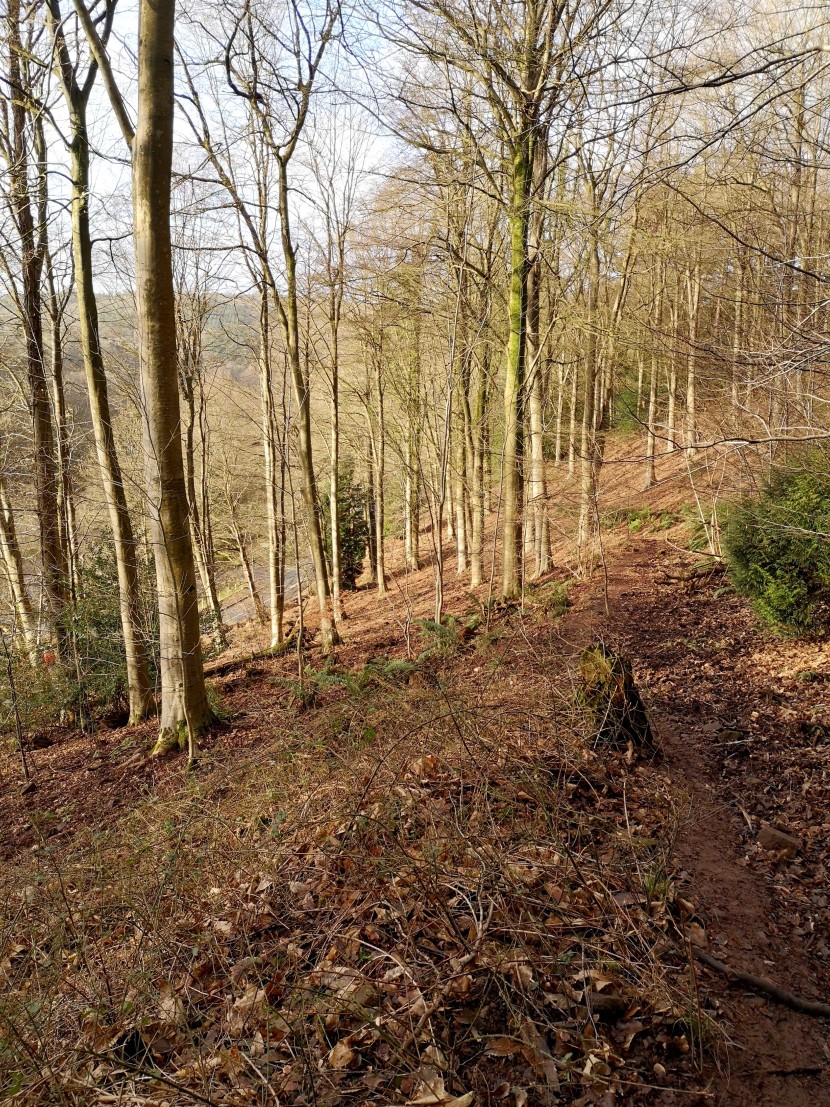 First days of spring in the Forest
First days of spring in the Forest The Northern Spider fisher. The southern dry fly man has a northern equivalent, one who is to be found on every river in the counties of Yorkshire and Lancashire and further north. The southern dry fly man is aware that they do things differently in the North and occasionally the two types will cross paths somewhere around Derbyshire. Nevertheless, despite much published propaganda about his very efficient fishing method, the spider fisher is still not so often seen in the southern half of Britain. This is despite the fact that many of the freestone streams of Wales and the West Country might seem like his natural territory. In his own way, the spider man is just as much of a traditionalist as the dry fly man, because he is well aware that many of his fly patterns are more than 200 years old. The general consensus is that anglers were fishing teams of flies wet all over the UK long before anybody thought of fishing on the surface. The spider man of the North Country will also have his heroes and will acknowledge his debt to writers like Stewart, Pritt, Walbran, and Edmunds and Lee. However, let us also accord our spider man a hint of northern practicality about his approach to fishing, because in my experience this chap does care about what he catches. “After all, what do we go fishing for?” would be his reasoning and he is certainly prepared for success with a method which can easily exceed the half century in a good fishing day. Of course, it is in the nature of the method and the rivers it is used on that many of these will be small fish…“but never mind that, lad.” Of course he will put up a dry fly at times if the conditions seem to recommend it, but the long soft rod with a team of three soft-hackled wet flies will normally be his starting point. Like his southern counterpart, the dedicated northern spider angler is also likely to have quite a few decades on the river under his belt. Younger men from Yorkshire and Lancashire will certainly know the method, but they will as likely be found heavy nymphing also. On the other hand the spider man would probably prefer to go out with the trotting rod for grayling in winter as a seasonal respite from his preferred method.
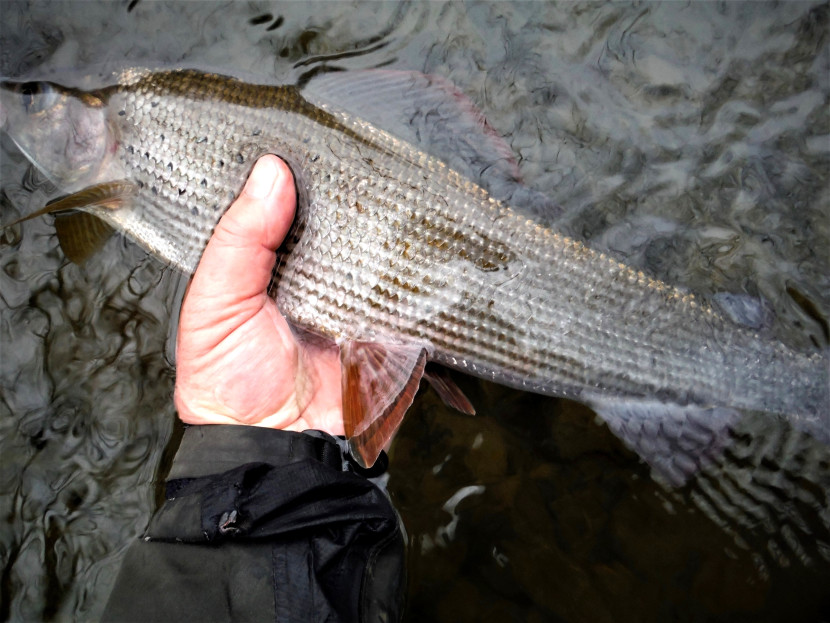 Cefnllysgwynne grayling
Cefnllysgwynne grayling 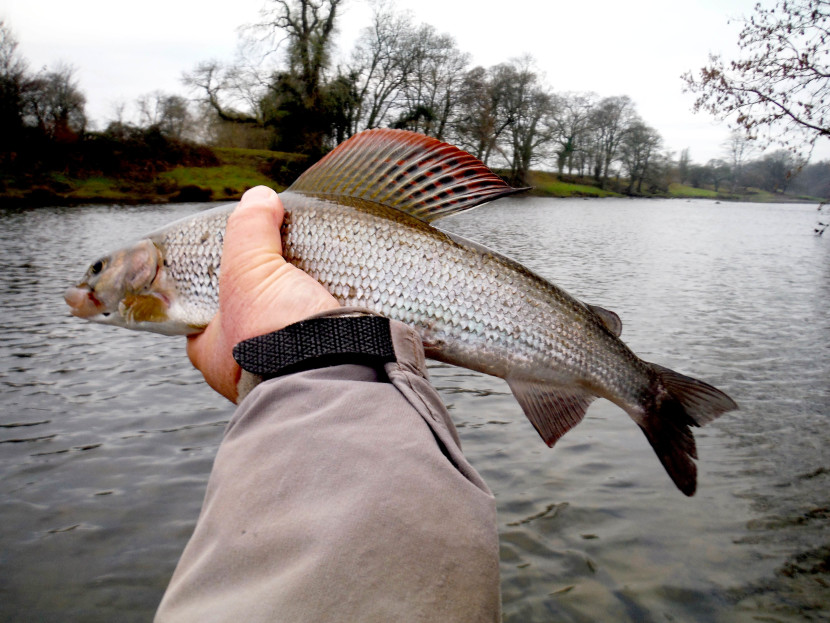 Builth Wells grayling
Builth Wells grayling 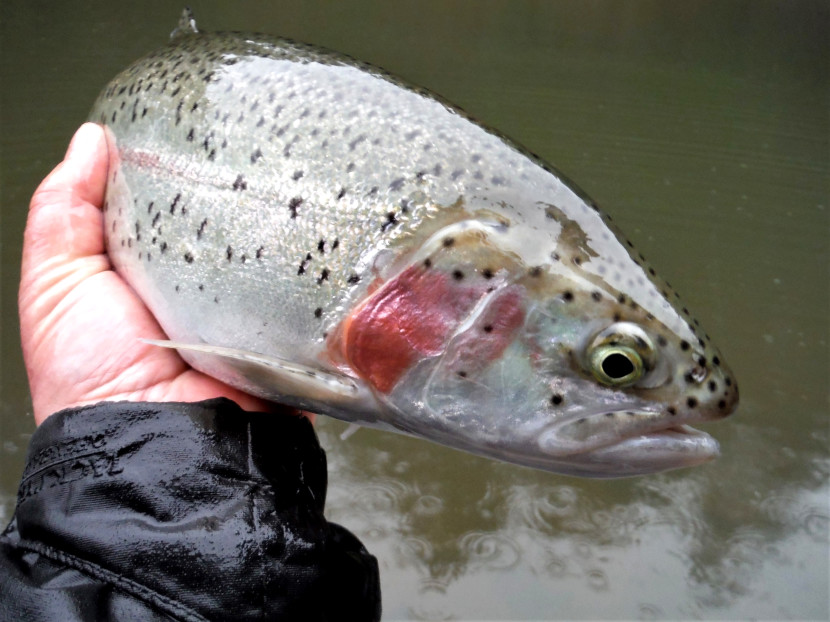 February rainbow
February rainbow The “Klink and Dink” man. This one might be younger by a decade than the first two described, perhaps in his fifties or early sixties now. He would have been a mature angler already, but alert to new developments and in a position to pay attention when the first magazine articles arrived describing the New Zealand method of suspending a nymph beneath a dry fly, offering either a nymph with an indicator or a sunken and a floating fly close to each other. This happened at the end of the last century and proved to be something like an epiphany for the Klink and Dink man. The dry fly is necessarily a buoyant one to support the nymph’s weight and a Klinkhammer is often chosen. A particularly interesting feature of the idea is that a short tippet can be tied directly to the bend of the dry fly hook to tether the nymph, although there are those who prefer the dry fly on a separate dropper. This method offering a “choice for the fish” proved so successful and effective that many took it up who have never really looked back and still tend to put up the “duo” as the first step in the fishing day. This very often works in the same situations where spiders might work, but is rather less liable to tangle than the team of three and also quite viable in small streams. The Klink and Dink man is quite proud of the way he has mastered a new method and still likes to think of himself as an experimental angler in his approach, reading all the latest articles and books.
The Heavy Nymphing specialist. I had some difficulty in choosing a name for this particular angler, because the sport as he practises it has been bedevilled by misleading descriptive names. A few years ago, he would have been known as a “Czech nymphing” specialist, a term which might still have some descriptive traction … unless of course you happen to be one of the Polish or Slovakian experts. “Close nymphing” or “East European-style nymphing” would have been more accurate, but somehow it never caught on in the way that “Czech nymphing” did. People describing the new method which arrived here in Britain just before the turn of the century would whisper the two words in something like awe, describing the technique which was said to be so devastatingly effective that it would catch the last fish in the river. Now you don’t hear so much about Czech nymphing, because there is a new magic phrase to be invoked. “French leader nymphing” is what is now all the rage and just as with AE Wood’s “greased line method” of salmon fishing 100 years ago, some pretty widespread confusion reigns about what exactly this means. For those who are not in the know, a Czech nymph is strictly speaking a pattern of fly imitating a caseless caddis grub and a French leader is simply an item of tackle longer than the normal one, and neither of these names are much help in understanding the method in question. As practised in the UK, the method involves fishing at close hand with little or even no fly line beyond the rod tip, trundling two or three heavy nymphs along the bottom, leading them downstream with the rod and striking into trout and grayling at close quarters. There is no casting as generally understood, but an upstream lob. It is quite a demanding method requiring alertness from the angler, but highly effective once the skill is mastered. I will go out on a limb here and suggest that your heavy nymphing man tends to be in his twenties, thirties or at the most his mid-forties. He follows competition closely, because this very efficient method has virtually taken over modern river competition. Even when pleasure fishing, he tends to fish to competition rules. Until recently he has been buying fly-tying and leader materials, even rods, from specialist outlets because the mainstream tackle industry has been slow to stock the items he needs. He makes much use of the internet to exchange ideas with other enthusiasts. The heavy nymphing man may just very occasionally put up a dry fly outfit, but it is the specialised 11 foot 3 weight rod with the fine tip which he uses most often. For more details on the use of French leaders, I would recommend Jonathan White’s book Nymphing the New Way which I reviewed in September 2016. To put the situation as simply as possible, very long leaders were originally developed for sight-fishing nymphs at long range to ultra-wary trout in the clear waters of the Doubs and Loue in the French Jura. However, these long leaders were not used at all in the same way in the UK, but rather for the normal close nymphing for fish which could not be seen, while the fly line and even the thick part of the leader remained on the reel. Now, to complicate matters, international competition rules have outlawed the early very long French leaders two and three times the length of the rod. As a result, the new section in the current Sportfish catalogue, again slightly confusingly named “French Nymphing,” offers two Snowbee leaders at 12.5 and 16 feet, and one by Rio at 11 feet. Nothing so very long about those, eh? I admit to feeling slightly superior about this as one of my own heavy nymphing outfits is still mounted with one of the original Hends tapered leaders of no less than 12 metres. That’s right; my leader is around 40 feet and I don’t often see the fly line. I can see a snobbery developing around this, just as in salmon fishing the chap still casting a full Spey line with a head of 75 feet is disposed to look down on those of us who have taken to casting 40 foot shooting heads. Make no doubt about it though; so many young anglers are practising these methods and so effectively that they must surely represent the future of fly-fishing.
The Tenkarista. All right, I admit that I just invented this word, as I know no other to describe an aficionado of fishing with a Japanese telescopic rod with no reel and a fixed leader. Tenkara has certainly proved to be a most seductive method once you have tried the tackle out and realise that it delivers a fly, hooks and plays fish beautifully. It can be used with dry fly, spiders or nymphs and it opens up a prospect of minimalist fishing with almost nothing to carry around with you. In fact I am extremely pleased that I decided to buy a Tenkara rod a few years ago. It certainly is a very attractive method and a relatively new one in the UK. Surprisingly, your Tenkarista is likely to be middle-aged and he may even be a member of the Grayling Society, because for some reason it is not the young who seem to go for Tenkara. I have a theory that the youthful heavy nymphing specialists are so affected by fishing to match rules, even when pleasure fishing, that anything excluded by the FIPS Mouche competition committee is beyond the pale – hence, no indicators and no Tenkara rods without reels. Tenkara does seem to me to be slightly obsessive, in that people who like this method often try to use it to the exclusion of every other and in all circumstances. A large part of its charm lies in its delicacy and the fact that you have very little to carry around with you. However, the sight of a Tenkarista wading the river with a whole sheaf of rods from 6 feet to 14 feet stacked in his back pack, so that he would be ready for every eventuality, made me smile. Surely avoiding that necessity was the reason extendable fly lines, rods with rings and fishing reels were invented in the first place? Rather sadly, the interest in Tenkara seems to have run its course in this country during the last couple of years.
Before anybody writes in accusing me of thoughtless sexism in this letter, I would just like to point out that I have used the word man as in “Dry Fly man” or “Klink and Dink man” with a reason. This is simply because I can’t think of a female angler I have met who fits any of these stereotypes. Women, for whatever reason, seem to be much more flexible in their approach to fishing and learning new methods. It’s somehow a male characteristic to discover something new, become filled with enthusiasm about it, and eventually mark it out as our comfort zone, never to be departed from again.
Me? I would be reluctant to go into that much self-analysis. I think I was very nearly a Northern Spider man once, even though I was born in Bristol. I can certainly empathise with the Southern Dry Fly man, who is the pleasantest of fellows to meet by the waterside. And I wish I knew more about the others. It’s all fishing.
Theoretically we open for trout and salmon fishing in just three days. I’m wary about predicting exactly how the spring fishing for trout will go when this frustrating period of floods is finally behind us. But sooner or later the waters will recede, after which we should reach the point where fly fishing will become less of an epic struggle against the elements and more of what we usually expect - a pleasantly gentle exercise, more intellectual than physical, involving just a wee bit of entomology. While we are complaining about the ceaseless rain and despite some lower temperatures during the last week, we should remember that there have been very few frosts this winter. In some ways I think we are almost a month ahead. We can expect to see – we already have seen – hatches of large dark olives. Generally all the spring hatches have been early in recent years and given the very warm temperatures of this last winter, it seems to me they are likely to be early again. Consider that by this mid-February, apart from the usual snow drops and crocuses, we already had a fine display of primroses, daffodils and even daisies on sheltered banks along with pink and white blossom in down town gardens. I have already seen the first green leaves on blackthorn hedges at Gloucester, fresh grass has been growing for several weeks now on the flatlands, rabbits are cropping it and the other day there were skylarks over the New Grounds behind the sea-wall.
So if the spring will continue to advance, we might expect the March browns to be early - meaning genuinely in March, not April - and the grannom sedge also might turn up in late March or certainly by early April. That particular hatch has been slightly disappointing over the last couple of seasons, but a big grannom hatch, should we get one, is a sight to remember. With the ground saturated and the rivers full, we are probably going to experience high water levels well into the spring. We may even, eventually, be grateful for that continuing high water, as at least better than a drought. It’s usually safe to suggest concentrating on the Usk initially. The upper Wye should be next to wake up, followed by the low altitude tributaries and finally the high altitude streams.
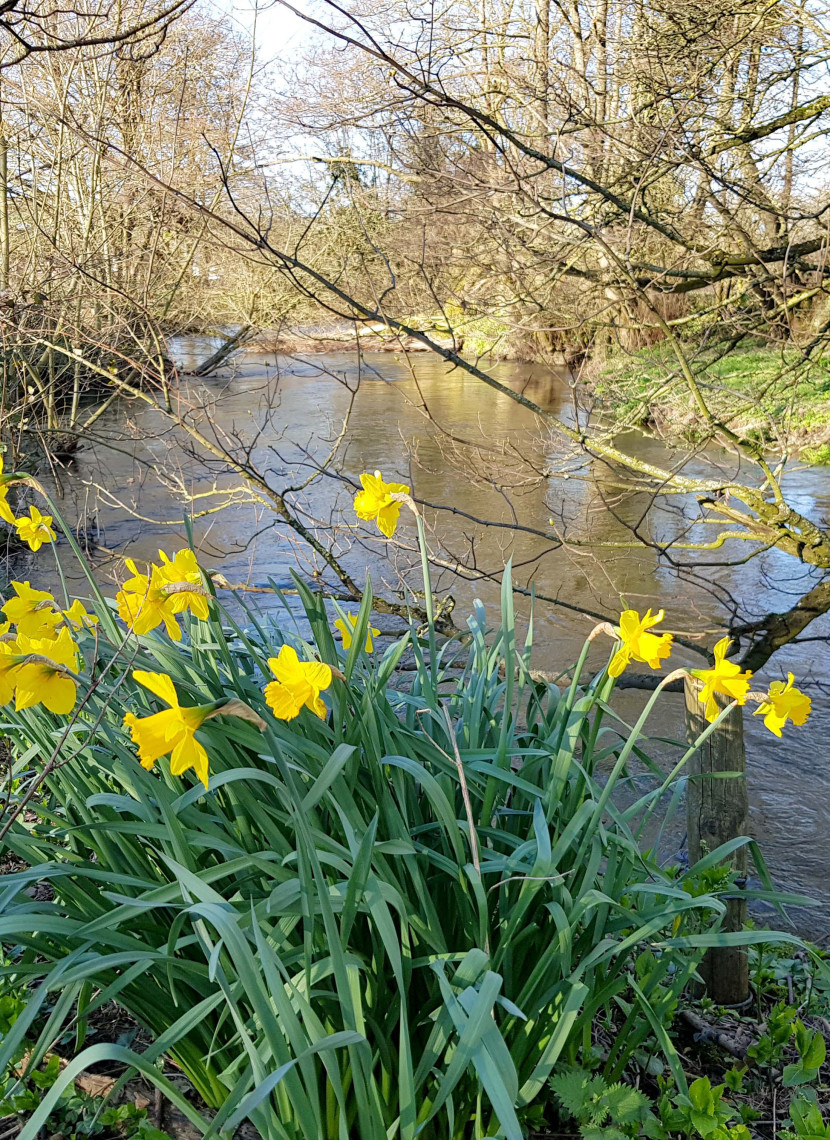
As for salmon, again with the recent high levels in mind, I’m going to take a punt and guess that the first springer will come from well up the middle Wye. The Usk is usually later. It was CV Hancock who wrote: “…the raw materials of a salmon fishing holiday are a few fish and a little water for them to swim in.” Fair enough, I suppose, but ask also that some of the fish should be players. Who knows, there might even be a portmanteau waiting. It is the Wye after all.
Incidentally, exercise a little caution as you enter familiar pools on the main rivers for the first time this year. After floods such as we have experienced, the bed of the river and the currents may well have moved. Big floods usually fill a pool with gravel, while subsequent and lesser spates gradually move it away again. Similarly gravel is mainly deposited in the powerful runs at the head of the pool; it is the back wash which chews away at the bank and creates deep holes. Take a staff and prod your way.
Tight lines!
Oliver Burch